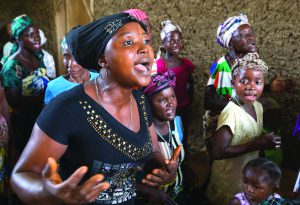Big Picture Status of United Methodism (Part 1 – Africa)

We are called Methodists for a reason. John Wesley was very methodical in his approach to discipleship (the means of grace, the General Rules) and revival. He always insisted that small groups be formed of those who responded to his preaching. He insisted that they follow a set process. And he kept detailed numbers on each group — who was participating and how often they attended. We sometimes get hung up on “numbers” vs. more spiritual topics, but each number represents a person. When we talk about gaining 5,000 members, we are talking about 5,000 more men, women, and children who are following Christ in a United Methodist congregation. And that is a great victory. And losing numbers of members is tragic. These numbers and these people matter for eternity.
Detailed statistics have been released by the General Council on Finance and Administration regarding membership numbers used to calculate the number of delegates for each annual conference to the 2020 General Conference. These numbers give us a better sense of the growth trajectory of our denomination. Year-to-year statistics are helpful, but there can be fluctuations. A four-year trend, as portrayed in the comparison between 2020 and 2016 numbers, can be more accurate in telling the overall story. (The numbers in determining the 2020 delegates come from 2016, as compared with 2012 numbers used to determine the 2016 delegates.)
The big picture is that The United Methodist Church gained more than 143,000 members over the past four years. All of the growth, however, took place in two of the African regions: Congo and West Africa. Every other region of the world declined in membership. Congo led the way by gaining more than 429,000 members, topping out at about 3 million United Methodists in the Congo alone. This makes Congo the largest region in the church, exceeding even the Southeastern Jurisdiction. West Africa followed by gaining nearly 200,000 members, coming to over 1.7 million United Methodists. This makes West Africa the third largest region in the world, behind the Southeastern Jurisdiction.
Observers were curious to see the impact of new rules for reporting members for 2016. For the first time, the membership numbers needed to be reported down to the individual church level. Previously, annual conferences outside the U.S. could report aggregate numbers for the whole annual conference, which were often thought to be just estimates that may not have been totally accurate. But the new 2016 numbers are far more reliable, and in many annual conferences in Africa the change did not have the effect of shrinking the membership.
There were still some anomalies in the African reporting. Two annual conferences in the Africa Central region (eastern and southern Africa) did not report their membership numbers. This contributed to the membership decline in the Africa Central Conference region, which lost 86,000 members. (There are issues of conflict in some of those annual conferences that also contributed to the decline.) Half of the annual conferences in this region grew, but the other half suffered some significant losses of 20 to 45 percent.
Another anomaly was that one West Africa annual conference (Cote D’Ivoire or Ivory Coast) reported the exact same number of members it had reported in 2012. Liberia led the way in West Africa with a growth of almost 133,000 members (89 percent). That country just elected its second United Methodist as president of the nation in a row! Sierra Leone gained 60,000 members (27 percent). The three annual conferences of Nigeria also grew slightly while adding a fourth annual conference and continuing to battle the adversity of the Boko Haram insurgency and internal church conflict.
All but two annual conferences in the Congo grew over the four years. The Oriental and Equator Annual Conference in the Congo went from 5,000 members in 2012 to over 90,000 members in 2016. Presumably, these recent numbers are more accurate. Two other annual conferences more than doubled in size. The largest annual conference (North Katanga) gained 90,000 members (11 percent). At 910,000 members, they are the largest annual conference in the global United Methodist Church, 2-1/2 times the size of North Georgia, the next largest! This rapid growth is why the Congo will probably receive the lion’s share of the four new bishops to be added in Africa in 2020.
Even with the anomalies, we have a much more accurate picture of the status of United Methodist membership in Africa and other parts of the world.
The big picture is that most of Methodism around the globe is in decline, with the exception of certain regions in Africa. In my next blog, I will look at the situation in the United States.
One thought on “Big Picture Status of United Methodism (Part 1 – Africa)”